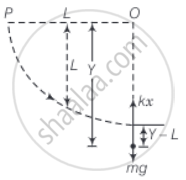Advertisements
Advertisements
Question
A stone of mass m is tied to an elastic string of negligble mass and spring constant k. The unstretched length of the string is L and has negligible mass. The other end of the string is fixed to a nail at a point P. Initially the stone is at the same level as the point P. The stone is dropped vertically from point P.
- Find the distance y from the top when the mass comes to rest for an instant, for the first time.
- What is the maximum velocity attained by the stone in this drop?
- What shall be the nature of the motion after the stone has reached its lowest point?
Solution
Consider the diagram the stone is dropped from point p.

a. Till the stone drops through a length Z it will be in free fall. After that, the elasticity of the string will force it to an SHM. Let the stone come to rest instantaneously at y.
The loss in PE of the stone is the PE stored in the stretched string.
`mgy = 1/2 k(y - L)^2`
⇒ `mgy = 1/2 ky^2 - kyL + 1/2 kL^2`
⇒ `1/2 ky^2 - (kL + mg)y + 1/2 kL^2` = 0
`y = ((kL + mg) +- sqrt((kL + mg)^2 - k^2L^2))/k`
= `((kL + mg) +- sqrt(2mgkL + m^2g^2))/k`
Retain the positive sign,
∴ `y = ((kLmg) sqrt(mgkL + m^2g^2))/k`
b. In SHM, the maximum velocity is attained when the body passes, through the “equilibrium, position” ie., when the instantaneous acceleration is zero. That is mg – kx = 0, where x is the extension from L.
⇒ `mg = kx`
Let the velocity be v. Then,
= `1/2 mv^21/22 kx^2 = mg(L + x)` .....(From the conservation of energy)
= `1/2 mv^2 = mg (L + x) - 1/2 kx^2`
Now, `mg = kx`
⇒ `x = (mg)/k`
∴ `1/2 mv^2 = mg(L + (mg)/k) - 1/2 k (m^2g^2)/k^2`
= `mgL + (m^2g^2)/k - 1/2 (m^2g^2)/k`
`1/2 mv^2 = mgL + 1/2 (m^2g^2)/k`
∴ `v^2 = 2gL + (mg^2)/k`
`v^2 = (2gL + (mg^2)/k)^(1/2)`
c. When the stone is at the lowest position i.e., at instantaneous distance Y from P, then the equation of motion of the stone is `(md^2y)/(dt^2) = mg - k(y - L)`
⇒ `(d^2y)/(dt^2) + k/m (y - L) - g` = 0
Make a transformation of variables, `z = k/m (y - L) - g`
∴ `(d^2z)/(dt^2) + k/m z` = 0
It is a differential equation of second order which represents SHM
Comparing with equation `(d^2z)/(dt^2) + omega^2z` = 0
Angular frequency of harmonic motion `omega = sqrt(k/m)`
The solution of the above equation will be of the type z = `A cos (omega t + phi)`, where `omega = sqrt(k/m)`
`y = (L + (mg)/k) + A^' cos (omegat + pi)`
Thus, the stone will perform SHM with angular frequency `omega = sqrt(k/m)` about a point `y_0 = L + (mg)/k`.
APPEARS IN
RELATED QUESTIONS
Two springs of force constants K1 and K2 (K1> K2) are stretched by same force. If W1 and W2 be the work done stretching the springs then......
The graph between applied force and change in the length of wire within elastic limit is a
- straight line with positive slope.
- straight line with negative slope.
- curve with positive slope.
- curve with negative slope.
Stretching of a rubber band results in _______.
(A) no change in potential energy.
(B) zero value of potential energy.
(C) increase in potential energy.
(D) decrease in potential energy.
Within the elastic limit, find the work done by a stretching force on a wire.
When rubber sheets are used in a shock absorber, what happens to the energy of vibration?
If a compressed spring is dissolved in acid, what happened to the elastic potential energy of the spring?
When a metal wire elongates by hanging a load on it, the gravitational potential energy is decreased.
When a string is stretched by 0.5 cm, its potential energy is U. If the string is stretched by 2 cm, then its potential energy will be:
When a string is stretched by 0.5 cm, its potential energy is U. If the string is stretched by 2 cm, then its potential energy will be:
